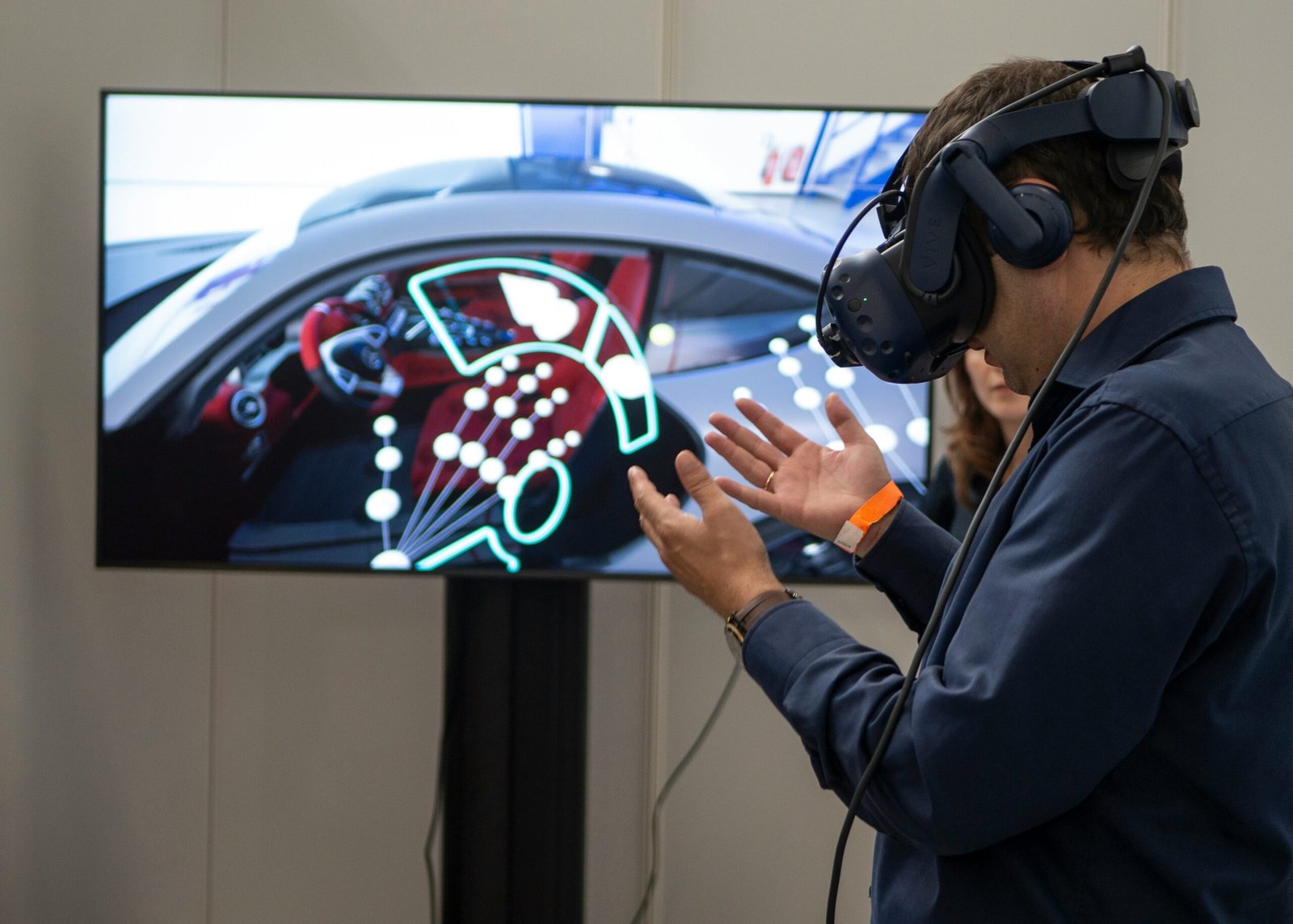
Introduction to Augmented Reality in Online Shopping
Augmented Reality (AR) is a technology that superimposes computer-generated images, sounds, or other data onto the real world, enhancing the user’s perception of their surroundings. This innovative technology has recently emerged as a transformative force in the retail sector, dramatically changing how consumers engage in online shopping. With the rapid evolution of e-commerce, AR has become instrumental in creating an immersive shopping experience that strives to mimic the tactile nature of traditional retail environments.
The evolution of online shopping has seen significant shifts over the past two decades, initially characterized by static product images and descriptions. While this format allowed customers to purchase products conveniently from home, it often lacked the interactive experience found in physical stores. As technology advanced, features like virtual fitting rooms and 360-degree product views were introduced. However, the advent of Augmented Reality marked a significant leap forward in enhancing customer interaction and satisfaction.
By integrating AR into online platforms, retailers can create a more engaging customer experience. Shoppers can visualize how products will look and fit in their own environments before making a purchase. For example, furniture retailers utilize AR to allow potential buyers to place virtual furniture in their homes, providing a clearer understanding of dimensions and aesthetics. Similarly, fashion brands employ AR to enable customers to try on clothes or accessories virtually, enhancing confidence in purchasing decisions.
In essence, augmented reality serves as a bridge between the tangible experience of in-store shopping and the convenience of e-commerce. As this technology continues to advance, its influence in online shopping trends is expected to grow, fundamentally transforming how consumers engage with products and brands in a digital marketplace.
The Rising Significance of AR in E-commerce
Augmented Reality (AR) is rapidly becoming a pivotal element in the realm of e-commerce, significantly transforming how consumers interact with products online. Recent statistics reveal that around 61% of consumers prefer retailers that offer AR experiences, highlighting its growing importance in enhancing customer engagement and satisfaction. As a result, businesses are increasingly investing in AR technology to provide immersive shopping experiences that facilitate informed purchasing decisions.
The global AR market is projected to reach an impressive $198 billion by 2025, exhibiting a compound annual growth rate (CAGR) of over 43%. This remarkable growth underscores the potential of AR to revolutionize online shopping by bridging the gap between virtual and physical retail. Various e-commerce platforms are adopting AR-enabled features, such as virtual try-ons, interactive product displays, and 3D visualizations, allowing consumers to visualize products in their space before making a purchase.
Moreover, the integration of AR into online shopping strategies aligns with evolving consumer trends. Today, shoppers seek personalization and interactive experiences, and AR delivers both. A survey indicated that 79% of consumers would prefer to shop with brands that offer AR experiences. This shift in consumer expectations signifies that brands must adapt to stay relevant. Businesses are exploring partnerships with AR technology providers and investing in custom solutions to enhance their online storefronts and satisfy customer demands.
As companies increasingly realize the competitive advantage that AR offers, we can anticipate a further integration of this technology into e-commerce platforms. With enhanced visualization capabilities and a focus on creating memorable shopping experiences, augmented reality is poised to play a crucial role in shaping the future landscape of online retail.
How Augmented Reality Enhances the Shopping Experience
Augmented Reality (AR) is revolutionizing the shopping experience by providing consumers with innovative ways to interact with products before making a purchase. One of the most notable implementations of AR is through virtual try-ons, which allow customers to visualize how clothing, accessories, or cosmetics would look on them. For instance, brands like Warby Parker and L’Oréal have integrated AR technology into their websites and mobile apps, enabling users to virtually “try on” eyewear and makeup from the comfort of their homes. This technology not only enhances consumer confidence but also reduces the likelihood of returns due to mismatched expectations.
Additionally, 3D product visualizations play a crucial role in transforming traditional online shopping. By providing lifelike representations, retailers can showcase their products in a more immersive manner. For example, IKEA’s AR app allows users to place virtual furniture in their living spaces, offering a unique perspective on how the item might fit into their home environment. Such features facilitate better decision-making, as customers can assess dimensions, colors, and styles with greater accuracy.
Moreover, interactive features facilitated by AR enable customers to engage more deeply with products. Brands like Nike utilize AR apps that allow shoppers to scan QR codes on products to unlock exclusive content, special offers, or detailed product information. This approach not only captures consumer interest but also fosters a connection between the brand and the shopper, elevating the overall shopping experience.
In the realm of online shopping, the integration of AR is paving the way for a more engaging and personalized experience. As more retailers adopt these technologies, the boundaries between physical and digital shopping are increasingly blurred, with AR at the forefront of this evolution.
AR Technology and Tools for Online Retailers
The integration of augmented reality (AR) in online retail has revolutionized the way consumers engage with products, enhancing their shopping experience significantly. Various AR technologies and tools have emerged to assist online retailers in integrating this advanced technology into their platforms effectively. These tools range from software solutions to AR development platforms that enable businesses to create immersive shopping experiences.
One of the most popular solutions in the market is ARKit and ARCore, developed by Apple and Google respectively. These software development kits enable retailers to build AR applications that can be seamlessly integrated into iOS and Android devices. By leveraging these tools, businesses can create interactive experiences that allow customers to visualize products in their own environments. For example, furniture retailers can provide AR experiences that let users see how a piece of furniture would look in their living rooms before making a purchase.
Additionally, specialized platforms like Shopify and Magento have also started incorporating AR capabilities. These platforms offer plugins that enable retailers to add AR features to their existing online stores without extensive technical knowledge. Other notable tools include Blippar, which specializes in AR creation, and Vuforia, which provides a comprehensive suite for AR development. These tools facilitate a multitude of use cases, including virtual try-ons for apparel and beauty products, helping consumers make informed purchasing decisions.
Moreover, advancements in 3D modeling and visualization technologies have further augmented the capabilities of AR in online retail. Retailers can now create high-quality 3D representations of their products, allowing shoppers to rotate and zoom in on items as they would in a physical store. As the technology continues to evolve, the potential for AR in reshaping the online shopping landscape appears promising, providing retailers with a significant competitive edge.
The Role of Augmented Reality in Reducing Returns
The integration of augmented reality (AR) into the online shopping experience is revolutionizing the way consumers interact with products before making a purchase. One of the most significant advantages of AR technology is its potential to substantially reduce return rates, which have become a pressing issue for many online retailers. By enabling virtual try-ons and more accurate product visualizations, AR provides customers with enhanced tools to evaluate products closely.
Virtual try-on features allow customers to visualize how a product, such as clothing or accessories, would look on them without physically trying it on. This not only provides a realistic representation of the item but also helps customers make more informed decisions, ultimately leading to greater satisfaction with their purchases. When consumers can see how a piece of clothing fits their body type or how a piece of furniture complements their living space, they are less likely to return items due to dissatisfaction.
Moreover, accurate visualizations offered by AR can bridge the gap between physical stores and online shopping. Customers can view products from various angles, zoom in on details, or even place items in their own environment using their smartphones or AR devices. This immersive experience minimizes ambiguity, allowing shoppers to feel more confident in their choices. As a result, misfit items or inadequate product expectations, which often contribute to return rates, can be significantly diminished.
In summary, by incorporating augmented reality into their platforms, online retailers can significantly enhance customer experience and satisfaction. The ability to try on products virtually, along with precise visual representations, empowers customers to make better purchasing decisions, leading to a notable reduction in returns—a major concern in the competitive realm of e-commerce.
Consumer Behavior and Preferences Towards AR Shopping
As the landscape of online shopping continues to evolve, augmented reality (AR) is emerging as a significant tool that reshapes consumer behavior and preferences. Surveys conducted among various demographics reveal a growing inclination towards interactive shopping experiences that AR technology offers. A notable proportion of consumers expressed that AR features enhance their online shopping experience by allowing them to visualize products in their intended environments. For instance, furniture retailers leveraging AR applications enable customers to see how a piece looks in their home before making a purchase, thereby reducing uncertainty and increasing confidence in their buying decisions.
Feedback collected from consumers highlights that usability remains a crucial factor in their acceptance of AR shopping. Shoppers prefer intuitive applications, which seamlessly integrate with their existing browsing experiences. Many respondents indicated a preference for AR functionalities that require minimal input while providing a rich visual experience. Consequently, retailers need to prioritize user-friendly interfaces that do not overwhelm consumers with complex navigation or excessive options. Additionally, the importance of mobile compatibility cannot be understated, as the majority of shoppers prefer to access AR experiences via smartphones and tablets.
The impact of augmented reality on purchase decisions cannot be overlooked. Many consumers reported that the availability of AR capabilities significantly swayed their intention to buy. This trend becomes even more pronounced among younger demographics who are more accustomed to new technologies. The sense of immersion and engagement offered by AR elements not only heightens interest in products but also encourages more substantial interaction with brands. As retailers analyze these trends, it becomes evident that integrating augmented reality into online shopping frameworks can effectively cater to consumer preferences, potentially driving sales and enhancing customer loyalty.
Challenges and Limitations of Augmented Reality in Online Shopping
As retailers increasingly adopt augmented reality (AR) technology to enhance the online shopping experience, several challenges and limitations have emerged that can hinder its widespread implementation. One significant challenge is the high development costs associated with creating AR applications. Developing a sophisticated AR platform requires substantial financial investment in technology, skilled personnel, and ongoing maintenance. Many smaller retailers may find it difficult to justify the initial expenditures, limiting the reach of AR solutions in the online shopping landscape.
Another constraint relates to the varying levels of customer access to AR-compatible devices. While smartphone technology has advanced considerably, not all consumers own devices capable of fully leveraging augmented reality features. This variation can create disparities in customer experiences, as those without AR-enabled devices may not benefit from the immersive shopping opportunities that their peers enjoy. Additionally, interoperability issues can arise, where AR applications may not function seamlessly across different platforms and devices, further complicating the user experience.
Moreover, there are significant concerns regarding user experience and how consumers perceive AR features. Retailers must ensure that AR technology enhances the shopping experience rather than complicating it. If AR applications are difficult to navigate or require extensive loading times, customers may become frustrated, leading to potential loss of sales. Furthermore, establishing trust in the AR visualizations is vital; consumers should feel confident in the accuracy of the virtual representations to avoid disappointment upon receiving their actual purchases.
In summary, while augmented reality presents exciting possibilities for revolutionizing online shopping, retailers face multiple challenges that must be addressed effectively. By acknowledging development costs, enhancing accessibility to AR-compatible devices, and prioritizing user experience, businesses can pave the way for more successful integration of AR technology in their retail strategies.
Future Trends: The Next Steps for AR in E-commerce
As consumer preferences evolve, the application of augmented reality (AR) in e-commerce is poised for significant advancements. Industry experts suggest that the intersection of AR with artificial intelligence (AI) will revolutionize the online shopping experience. This powerful combination can deliver more personalized product recommendations, enhancing user engagement and satisfaction. By analyzing individual shopping behaviors and preferences, AI algorithms can tailor AR experiences, making them even more relevant to shoppers.
Furthermore, the integration of AR with other emerging technologies, such as virtual reality (VR) and the Internet of Things (IoT), holds immense potential. For instance, IoT devices can provide real-time data about inventory levels, allowing AR applications to inform consumers about product availability in various locations. This synergy can create a seamless shopping journey, transitioning smoothly from exploration to purchase, ultimately enriching the overall consumer experience.
Another anticipated trend is the shift towards advanced AR functionalities that facilitate interactive shopping experiences. Innovations such as virtual try-ons are expected to become commonplace, enabling consumers to visualize how products fit into their lives before making a purchase. This not only decreases the likelihood of returns but also instills greater confidence in buying decisions. Enhanced interactivity can further amplify social shopping experiences, allowing users to share AR content with friends and family during the decision-making process.
Retailers are also expected to invest in creating immersive environments through gamification of the shopping experience using AR technology. Such applications can turn shopping into an engaging adventure, encouraging loyalty and repeat visits. By exploring novel methods to leverage AR, businesses will not only attract more customers but also foster long-term relationships by addressing the evolving needs of consumers.
Conclusion: Embracing Augmented Reality for Retail Success
As the retail landscape continues to evolve, augmented reality (AR) emerges as a pivotal tool for enhancing customer experiences and driving engagement. The integration of AR in online shopping represents not only a technological advancement but also a strategic imperative for retailers aiming to remain competitive in an increasingly digital marketplace. By allowing customers to visualize products in their own environment before making a purchase, AR removes uncertainty and fosters a deeper connection between the consumer and the product.
Throughout this exploration of augmented reality, we have highlighted its transformative potential in reshaping how consumers interact with brands and products. From virtual try-ons to interactive product displays, the applications of AR are vast and varied. Retailers that prioritize these technologies are positioned to capture a more engaged audience, ultimately leading to increased sales and customer loyalty.
Moreover, the adoption of augmented reality can enhance brand perception and differentiate a retailer in a crowded market. As consumers gravitate toward companies that leverage innovative solutions, those that invest in AR are likely to develop a reputation as forward-thinking and customer-centric. Retailers should consider integrating AR into their current strategies, not merely as a gimmick but as a vital component of their customer engagement toolkit.
In conclusion, the embrace of augmented reality in retail presents a valuable opportunity for businesses seeking to elevate their customer experience. By acknowledging the importance of AR and its influence on consumer behavior, retailers can unlock new avenues for success and transform challenges into opportunities in the digital shopping era. Now is the time for retailers to invest in augmented reality, ensuring that they stay ahead of the curve and cater to the evolving needs of their customers.

